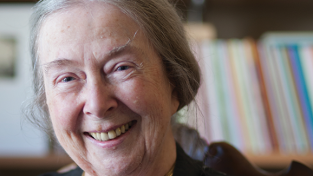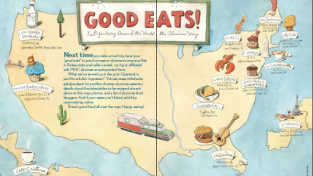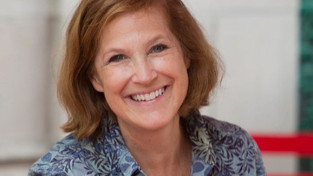Wine: Time in a Bottle
Wine is a time capsule. Every bottle tells a story,” says Nicole Brun-Cottan FP ’05, who gave up a career in glass artistry in 2008 and moved to Sonoma County, California, to apprentice at a winery. She lived in a 350-square-foot home with an outhouse, three miles from paved roads, working for free with no vacation to learn every aspect of the business. Today she has her own very own label, called girl. dog. truck.
Such is the draw of wine. Complex, mysterious, so alluring—the provenance of a select few who possess the right palate, the right vocabulary, and the right budget. That’s the popular misconception, anyway. But the vibrant Mount Holyoke alumnae beguiled by the world of wine—from vintners to chefs to teachers—say that it draws people together through history, discovery, and camaraderie. “Whose hands were harvesting these grapes? How old is the land? Is it family-owned? There’s a surprise in every glass,” says Vermont-based Corey Burdick ’02, who has worked in both the corporate and restaurant sides of the wine business.
Pulling Up Roots to Lay Down Vines
Uncorking a bottle and pouring wine into a glass is a relaxing ritual, but actually running a vineyard is a painstaking process—a calling, really—that requires devotion and upheaval. Before operating her family’s vineyard, Molly De Hetre Meeker ’74 worked with legendary television producer Norman Lear. Her husband, Charlie, a longtime wine aficionado, was the head of MGM Studios in Los Angeles. A charmed life, but ultimately they decided to abandon it in favor of a quieter existence running their own winery in Sonoma County, where she and her husband now play the blues, greet visitors, and work alongside their grown son, Lucas. “It’s a way of putting your name on something that you did that’s also associated with happy times. People are generally having a good time when they’re drinking wine. She’s proud of running a “good family-owned winery”—The Meeker Vineyard—which was hailed by the Wall Street Journal as one of the best wine-tasting experiences in Napa and Sonoma counties.
Dominique Hoover De Vito ’83 tells a similar story. She and her husband, Carlo, had successful careers in publishing but opted to flee New York City for upstate New York’s Columbia County, an area with a rich agricultural history. They bought an old farmhouse on fourteen acres in 2006, planted their first thousand grapevines in May 2006, and opened a tasting room the following year. “We traveled extensively and always went to wineries whenever we were on vacation,” De Vito recalls. “On our ten-year anniversary, we went to ‘wine camp’ on Long Island, a behind-the-scenes introduction to winemaking and running a vineyard. My husband took it really seriously. He said, ‘Hey, we could do this!’ Our ‘rosé-colored glasses’ were firmly in place,” she jokes. While her husband still commutes to his day job in New York City, Dominique’s career has been consumed by wine. The family’s Hudson-Chatham Winery is Columbia County’s first. The intensity of building a vineyard from scratch isn’t for everyone, but “complete vineyard packages come up for sale all the time,” she says, “You can even be a‘garagista’—making wine in your garage with a kit.”
Choosing the Right Wine
It’s possible to step outside your wine comfort zone without launching your very own vineyard, though. On a smaller scale, Nicole Brun-Cottan suggests experimenting with new wines at tasting parties. “Everyone can bring a bottle that they’ve never heard of to keep costs down,” she says. Meeker also suggests joining a wine club, in which a winery will send customers shipments of different types of wine for a discount. It’s a reliable, low-risk way to experiment with wines until you find a favorite, all while supporting one winery.
Behind-the-scenes experimentation is fine, of course, but what about the big business dinner or the crucial first date? It’s tempting to stare down a mile-long wine list and grasp at whatever looks familiar. Alana O’Neal ’07 works at Two Sisters Bar and Books in San Francisco’s Hayes Valley neighborhood. Two Sisters is known for its wine list—and she’s used to easing patrons into trying new bottles of wine. “There can be this belief around wine that you’re tasting it ‘wrong’ somehow, if you don’t have the vocabulary or because you weren’t raised with it. You’re not doing anything wrong by just enjoying it,” she says. At restaurants, don’t be afraid to ask for a sample of a by-the-glass wine you’re curious about; most places will happily oblige. If you do find something you love, by all means, pull out the iPhone and snap a photo. “Take a pic of the label and bring it back to your wine shop,” Meeker says. “You’ll look informed.”
Of course, that involves finding the right wine shop. When buying wines for home, “The best thing to do is go to a local wine or liquor store and get to know the staff,” says De Vito. “Talk to the owner. He or she will be your expert.” It’s important to find a shop where you feel welcome and comfortable having a conversation. To help your wine seller, be prepared to answer the following questions: “Do you like red or white? People kind of know that. Then basic characteristics: fruity, sweet, dry? People tend to have a sense of what they like. And then be ready to discuss how much you want to spend. It’s a matter of personal taste,” she says. “It’s like making a spaghetti sauce. People have this idea in their head of what a perfect one tastes like. When they cook at home, they make it taste how they want. Wine is the same. Your impression of a fruity red might not be mine,” she says. Finding your personal favorite is a subjective process.
If you do want to brush up on your wine vocabulary before chatting with your friendly wine professional, invest in an aroma wheel. Abigail Hitchcock ’94, chef-owner at New York City’s Camaje Bistro and a certified sommelier, says that “an aroma wheel helps you decide what you’re smelling. There are hundreds of thousands of things you can smell. It’s a pie chart that breaks down smells into categories such as fruit or chemical, and further breaks them down into, for example, berries vs. citrus, then further into strawberries vs. blueberries, and so on.” University of California–Davis Professor Emerita Ann C. Noble developed the wheel, and it’s available online starting at $6—the perfect treat for an aspiring oenophile.
Also, don’t turn up your nose if your wine seller suggests a wine with a screw-cap top. Although once derided as the hallmark of a lesser wine, these days it’s common. In fact, sometimes it’s better, because cork oak can infect the wine. Explains Meeker, “It just takes one little micron. And the most dangerous part is, if it’s badly corked, the wine will smell like mildew or a wet dog in a phone booth. You should smell fruit.” Hitchcock agrees: “The cork is there to have the vineyard or name of the wine on it. It is trying to prove that the wine in the bottle is what it should be. Screw caps are totally OK.” Even though it’s thrilling to hear that “thwoop” when a cork is pulled—a screw cap isn’t as ceremonious—there’s absolutely no shame in a screw-top wine.
Stocking Your Cellar
Despite your personal preferences for red or white, cork or cap, bold or light, it’s considerate to have people-pleasing wines on hand for guests. Corey Burdick recommends chardonnay aged in stainless steel: “It doesn’t hit you in the face. It’s not oaky or buttery. Chardonnay gets a bad rap. Also, in the white field, stock a good chenin blanc—it’s just a crowd-pleaser. It has some slight sweetness, a little minerality, it’s an interesting wine, and there’s almost nobody in a group who will spit it out.” As for reds, she recommends stocking a light-bodied pinot noir, since many wine novices shy away from bolder reds.
It’s also wise to avoid high-alcohol-content wines. Says O’Neal, “If you’re looking for something to enjoy with food and other people, I typically look for wines that are lower in alcohol content. Alcohol dulls your palate. It doesn’t make for good long-term drinking. By the time you finish the glass, you’re not tasting it anymore. At 15 or 16 percent, you’re not in tasting territory.” Every bottle of wine advertises its alcohol content on the label. As a rule, red wines tend to be higher in alcohol than whites.
Of course, beyond taste and budget, it’s important to find wineries worth supporting. It’s easy to go for a wine that has a cute label, even if that wine is from a large distributor that might not be especially innovative or eco-friendly. Says Brun-Cottan, “So much of wine is completely mechanized, paint by numbers. A large company has a product that they want to be the same every year, because the clientele is used to it. They can’t take a risk.”
Burdick suggests reading Wine Spectator or Wine Enthusiast to get a sense of the playing field. She tries to support small, independent, woman-owned wineries. “I’m reluctant to purchase the big labels. How much care is going into the process? I also keep my eye out for women producers. There are more and more women in the wine world now,” she says. Learning about the people who are actually making the product adds a whole new dimension to the experience. As Brun-Cottan says, “Wine’s a unique expression of a constellation of variables, a particular geography of place and season, and the choices made by all the people who handle the fruit.”
Wine instructor Caroline Hermann ’92, who is based in Washington, DC, suggests getting ideas from a knowledgeable wine seller or a friend who enjoyed a particular bottle, or exploring a certain grape by trying it from different countries. Another approach is to find an importer whose portfolio you like. Two nationally known importers are Kermit Lynch in Berkeley, California, and Robert Kacher in Washington, DC. Both importers work with small, sustainable family-owned winemakers, mostly in Europe and bring back to the States wines at all prices.
Why is wine so magical? “It is a product that is both a science and an art, alive and changing in the bottle and, once poured, in the glass,” says Hermann. “Wine can enhance both a meal and conversation—and it makes people happy.” We’ll drink to that.
—By Kara Baskin ’00
—Photos by Deirdre Haber Malfatto
This article appeared in the winter 2013 issue of the Alumnae Quarterly.
February 8, 2013















Certainly will drink to that.
She and her husband, Carlo, had successful careers in publishing but opted to flee New York City for upstate New York’s Columbia County